What is Hemangiosarcoma in Dogs?
Hemangiosarcoma is a cancer in dogs that can affect any organ in the dog’s body including the spleen, liver, heart and skin.
It is an aggressive cancer that causes many signs and symptoms in the pet, but these are difficult to decipher as signs of hemangiosarcoma.
The hemangiosarcoma tumours consist of blood vessels that are often abnormal, invasive, fragile and easily ruptured. The detection usually occurs when the tumour ruptures. The rupture results in bleeding into the body cavity (abdomen or chest), which results in the clinical signs commonly associated with hemangiosarcoma.
Which Dog Breeds are Predisposed to Hemangiosarcoma?
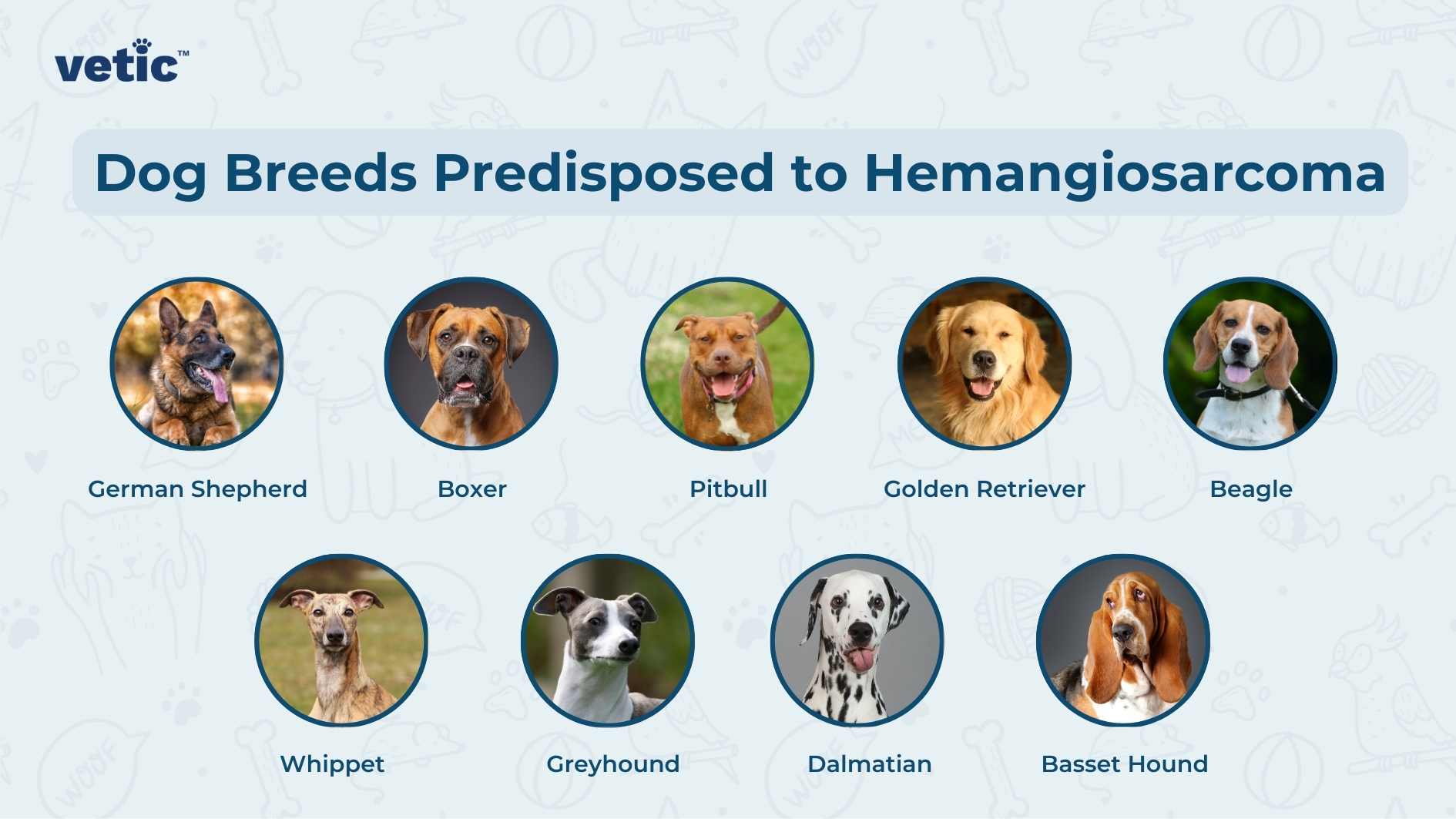
Hemangiosarcoma is commonly diagnosed among middle-aged to senior dogs. Some dog breeds are more predisposed to the cancer as compared to others, including –
- German Shepherd
- Boxer
- Pitbull
- Golden Retriever
- Beagle
- Whippet
- Greyhound
- Dalmatian
- Basset Hound
Is Hemangiosarcoma in Dogs Genetic?
A recent study published in the American Association for Cancer Research has stated that specific breeds such as the Golden Retriever carry heritable genetic factors that put them at a higher risk of developing hemangiosarcoma in their adulthood.
Veterinarians and researchers across the world are noting a genetic trend in the development of hemangiosarcoma among the predisposed breeds.
What are the Most Common Types of Hemangiosarcoma in Dogs?
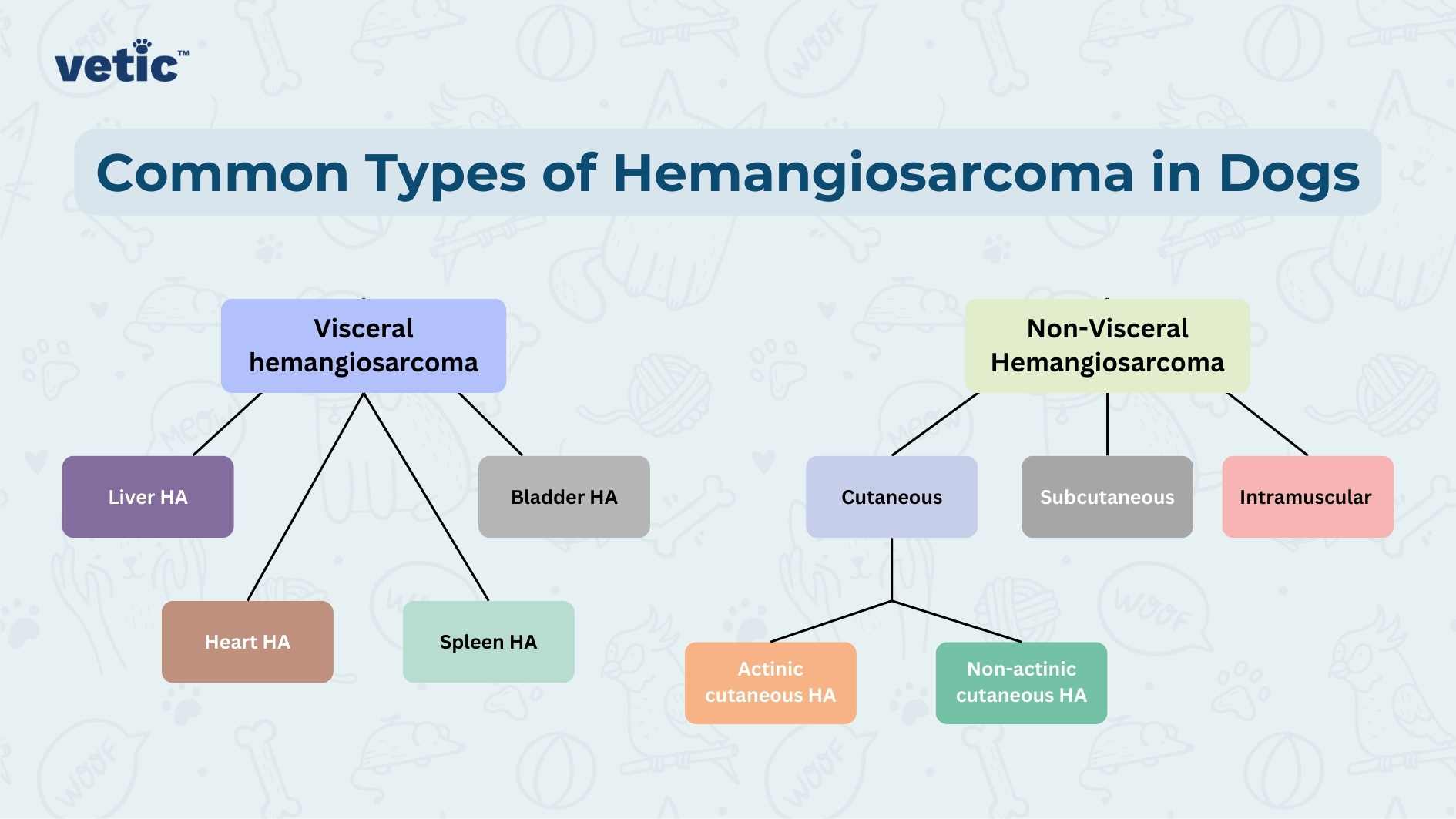
Hemangiosarcoma in dogs are broadly classified into two categories – Visceral and non-visceral
Visceral hemangiosarcoma:
Visceral hemangiosarcoma commonly affects internal organs such as the liver, heart, spleen, bladder, kidneys, bones, uterus, lungs, tongue, oral cavity, and space behind the abdominal cavity (retroperitoneum).
Visceral hemangiosarcoma is the most aggressive and destructive since the rupture of a tumor located in any of these critical organs can disrupt the functioning of the particular organ, release blood into the abdominal/chest cavity, and cause severe blood loss.
Non-visceral hemangiosarcoma:
Non-visceral hemangiosarcoma is primarily categorized into cutaneous (skin), subcutaneous, and intramuscular. Canine cutaneous or skin hemangiosarcoma is the most common among non-visceral hemangiosarcoma. It is further subdivided into actinic and non-actinic hemangiosarcoma.
Actinic hemangiosarcoma is commonly associated with sun exposure and noted among white, short-haired breeds, such as the whippet, greyhound, pit bulls, and dalmatians. The non-actinic type is common among breeds with deeper pigmentation and thicker coats irrespective of sun exposure.
What is Hemangiosarcoma of the Skin?
Hemangiosarcoma of the skin is a cancer of the skin that can affect middle-aged and senior dogs. There is no gender predisposition.
Most commonly reported dog breeds with hemangiosarcoma of the skin include lighter-skinned and thin-haired dogs such as the Whippet, Pitbull, Greyhound, Dalmatian, Boxer and Beagle.
The occurrence of actinic cutaneous hemangiosarcoma in dogs is directly proportional to sun (UV) exposure in the lightly pigmented dogs. Non-actinic hemangiosarcoma of the skin doesn’t depend on sun exposure and it can affect dogs with pigmented skin and thick fur as well.
Actinic cutaneous hemangiosarcoma is relatively less aggressive as compared to the non-actinic form.
What are the Signs of Hemangiosarcoma in Dogs?
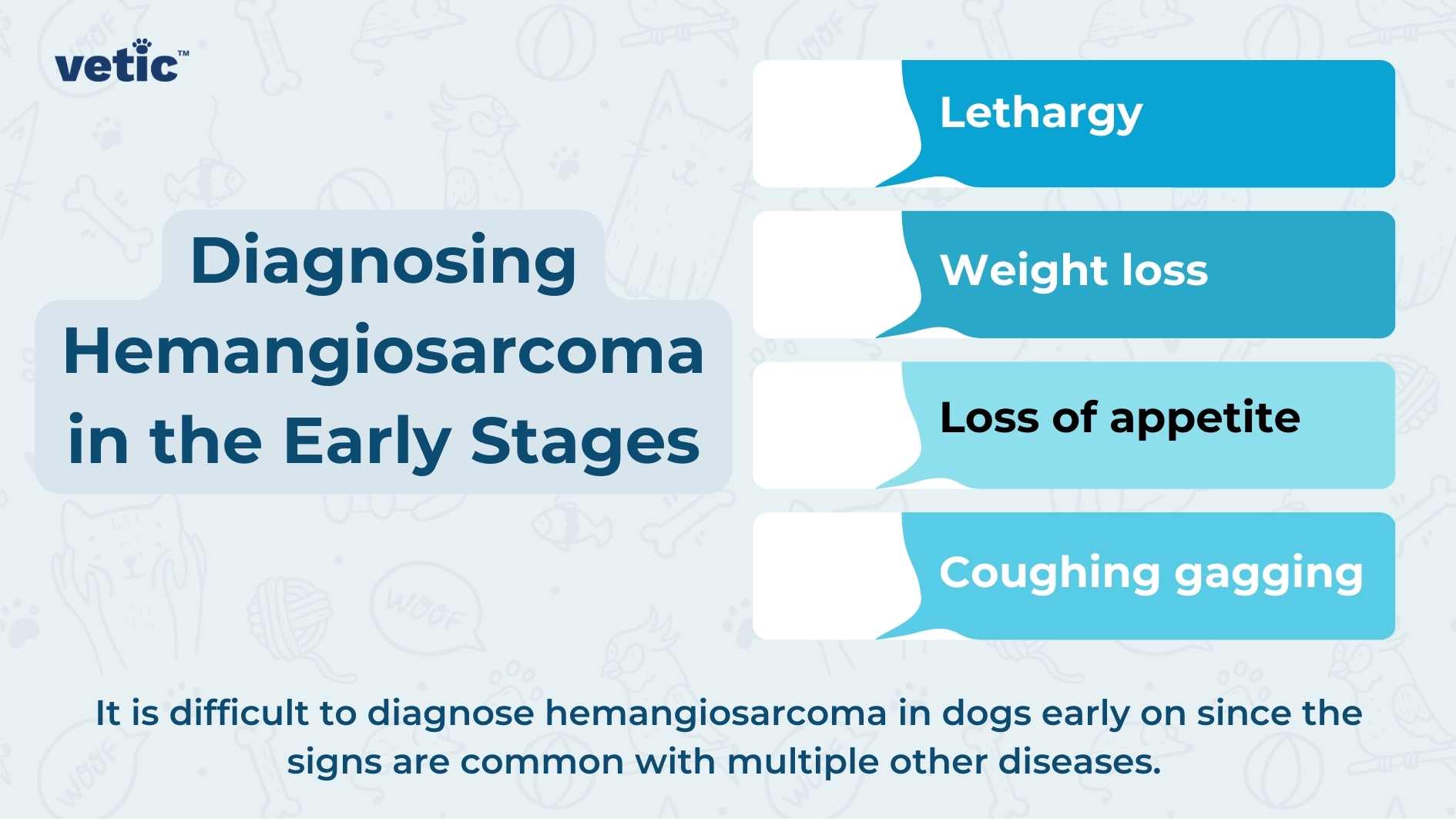
Hemangiosarcomas in dogs can be particularly sneaky and sadly, most of the signs go unnoticed until the tumours burst and cause internal bleeding.
Here are some of the different types of hemangiosarcoma in dogs and their different signs –
The signs of hemangiosarcoma will differ depending on the organs involved. However, almost all of these malignant tumours are highly aggressive and have the potential to cause heavy bleeding.
Splenic Hemangiosarcoma: Understanding the Warning Signs
The spleen is often affected by hemangiosarcoma, leading to large, blood-filled tumours. These tumours are fragile and can easily rupture, resulting in significant internal bleeding. While some dogs may not show symptoms initially, most pet parents notice signs when the tumour ruptures.
- Weakness
- Pale gums
- Lethargy
- Decreased appetite
- Swollen or distended abdomen
Cardiac Hemangiosarcoma: Recognizing Heart-Related Symptoms
When hemangiosarcoma affects the heart, it weakens the organ’s ability to pump blood efficiently. The tumours are prone to bleeding, leading to fluid accumulation around the heart and lungs. As the condition progresses, you may notice:
- Sudden collapse
- Extreme fatigue or lethargy
- Weakness
- Persistent coughing
- Difficulty breathing
- Reduced tolerance for exercise
- Vomiting
Cutaneous/Subcutaneous Hemangiosarcoma: Spotting Skin-Related Signs
Skin hemangiosarcoma appears as a bump, blister, or nodule on or just beneath the skin. Dogs with this type often remain healthy if the tumour is detected early. However, in more advanced cases, you might observe:
- A red or purple mass, especially in areas with less fur like the abdomen or legs
- Bruising around the tumour
- Bleeding from the tumour
- Lethargy, lameness, loss of appetite, or weakness in more aggressive cases
What Causes Hemangiosarcoma in Dogs?
Although it is quite a common cancer in multiple breeds, the exact cause(s) are still unknown. Recent studies show there’s a genetic link among the predisposed breeds.
Cutaneous hemangiosarcoma has been related to UV exposure in some light-pigmented breeds. However, even dark-pigmented dogs with a thick fur coat can get cutaneous hemangiosarcomas.
How is Hemangiosarcoma Diagnosed?
How is Hemangiosarcoma in Dogs Diagnosed?
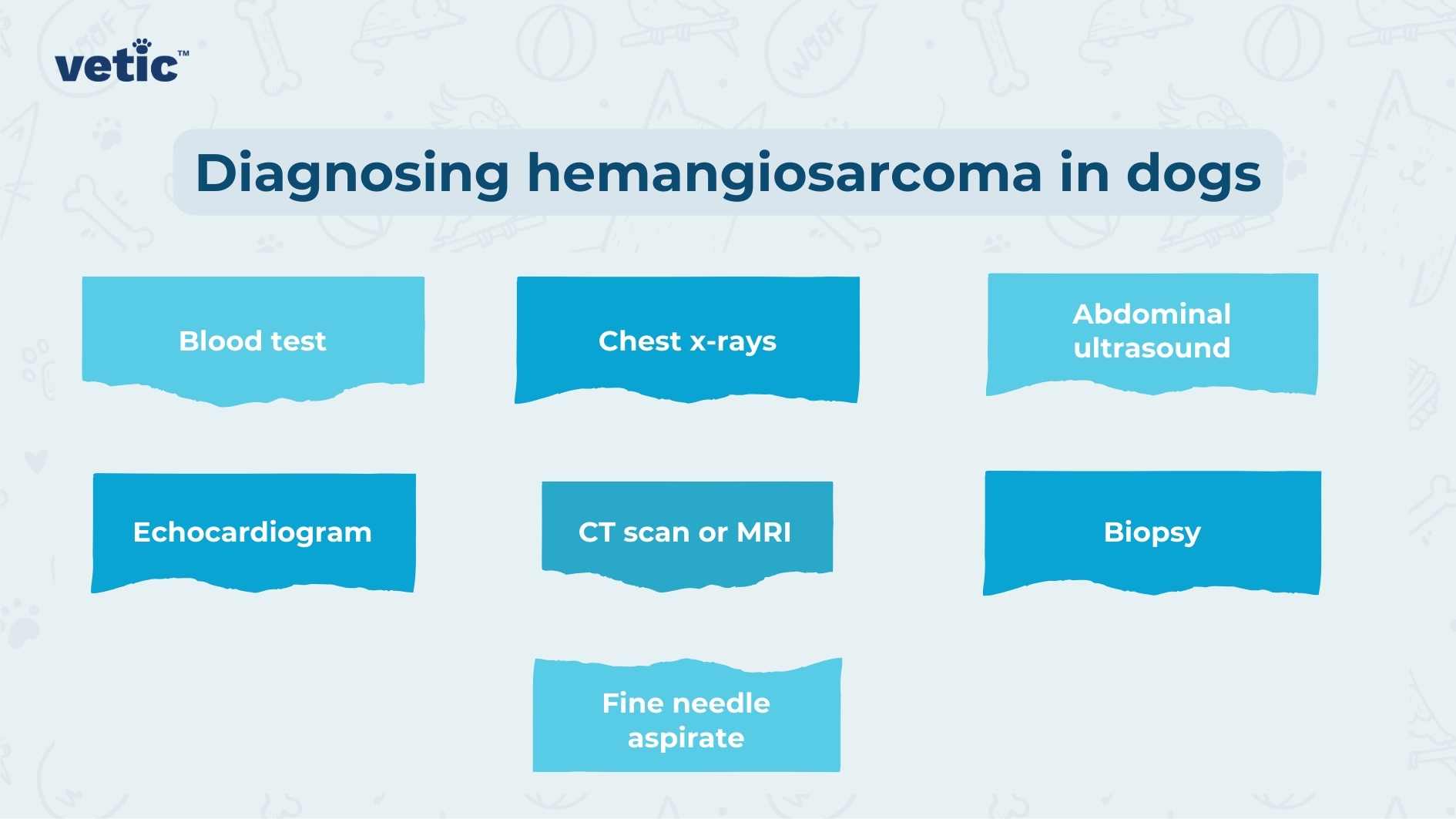
Diagnosing hemangiosarcoma in dogs requires a careful assessment by a veterinarian. Since this cancer can appear in different parts of the body, the tests and steps needed to diagnose it may vary. Here’s a simple guide to how hemangiosarcoma is typically diagnosed:
General Diagnostic Steps
If a veterinarian thinks your dog might have hemangiosarcoma, they’ll likely recommend several tests to understand how severe the cancer is and how much it has spread. This helps decide on the best treatment and gives an idea of what to expect. Common tests include:
- Blood tests: To check for issues like anaemia or other blood abnormalities.
- Chest x-rays: To look for tumours in the lungs or signs that the cancer has spread.
- Abdominal ultrasound: To examine the spleen, liver, and other organs in the abdomen.
- Echocardiogram (heart ultrasound): To check the heart for tumours or abnormalities.
- Advanced imaging (CT scan or MRI): To get a clearer picture of how far the cancer has spread.
Diagnosing Splenic Hemangiosarcoma
Splenic hemangiosarcoma often shows up after a sudden collapse or when a dog becomes weak because a tumour has burst. Sometimes, the tumour is found during a routine check-up when the vet feels an enlarged spleen or spots a mass on an x-ray or ultrasound. To confirm the diagnosis:
- Biopsy of the spleen: A small tissue sample from the spleen is taken and examined by a pathologist to determine if cancer is present.
Diagnosing Cardiac Hemangiosarcoma
When hemangiosarcoma affects the heart, it’s usually found through an echocardiogram. Your vet might suspect a heart tumour if your dog has:
- Collapse episodes
- Signs of heart failure
Sometimes, these tumours are found during routine chest x-rays. To diagnose:
- Echocardiogram (heart ultrasound): Helps detect tumours around the heart.
- Biopsy: While it can confirm the diagnosis, a biopsy of heart tumours is risky and often not done. Most cardiac tumours are assumed to be hemangiosarcoma based on other evidence.
Since heart tumours often appear with splenic hemangiosarcoma, the vet will also check other organs like the liver and lungs for signs of cancer.
Diagnosing Cutaneous/Subcutaneous Hemangiosarcoma
For skin-related hemangiosarcoma, the process usually starts with a simple test called a fine needle aspirate (FNA):
- Fine needle aspirate (FNA): The vet uses a needle to collect a small sample of cells from the tumour, which is then examined under a microscope. However, since these tumours are often filled with blood, FNAs might not always give a clear result.
- Surgical biopsy: If the FNA doesn’t provide enough information, the vet may take a larger tissue sample through surgery to confirm if it’s hemangiosarcoma.
Can Hemangiosarcoma in Dogs be Treated?
The treatment of hemangiosarcoma may involve surgery. However, it is not always recommended since the tumour can grow on vital organs such as the heart. Surgeries are mostly recommended for skin hemangiosarcoma and splenic hemangiosarcoma.
Several forms of hemangiosarcoma require radiation and chemotherapy. Chemotherapy can slow the growth of the tumour.
Sadly, chemo and radiation cannot cure hemangiosarcoma in dogs. However, it can give them a few additional months and improve their quality of life.
Other supportive medications and treatments are given with chemotherapy and radiation therapy, including –
- Medicines to stop bleeding
- Thoracentesis
- Abdominal tap or paracentesis
- Drugs to stabilise heart function
- Blood transfusions
Are All Types of Hemangiosarcoma Aggressive?
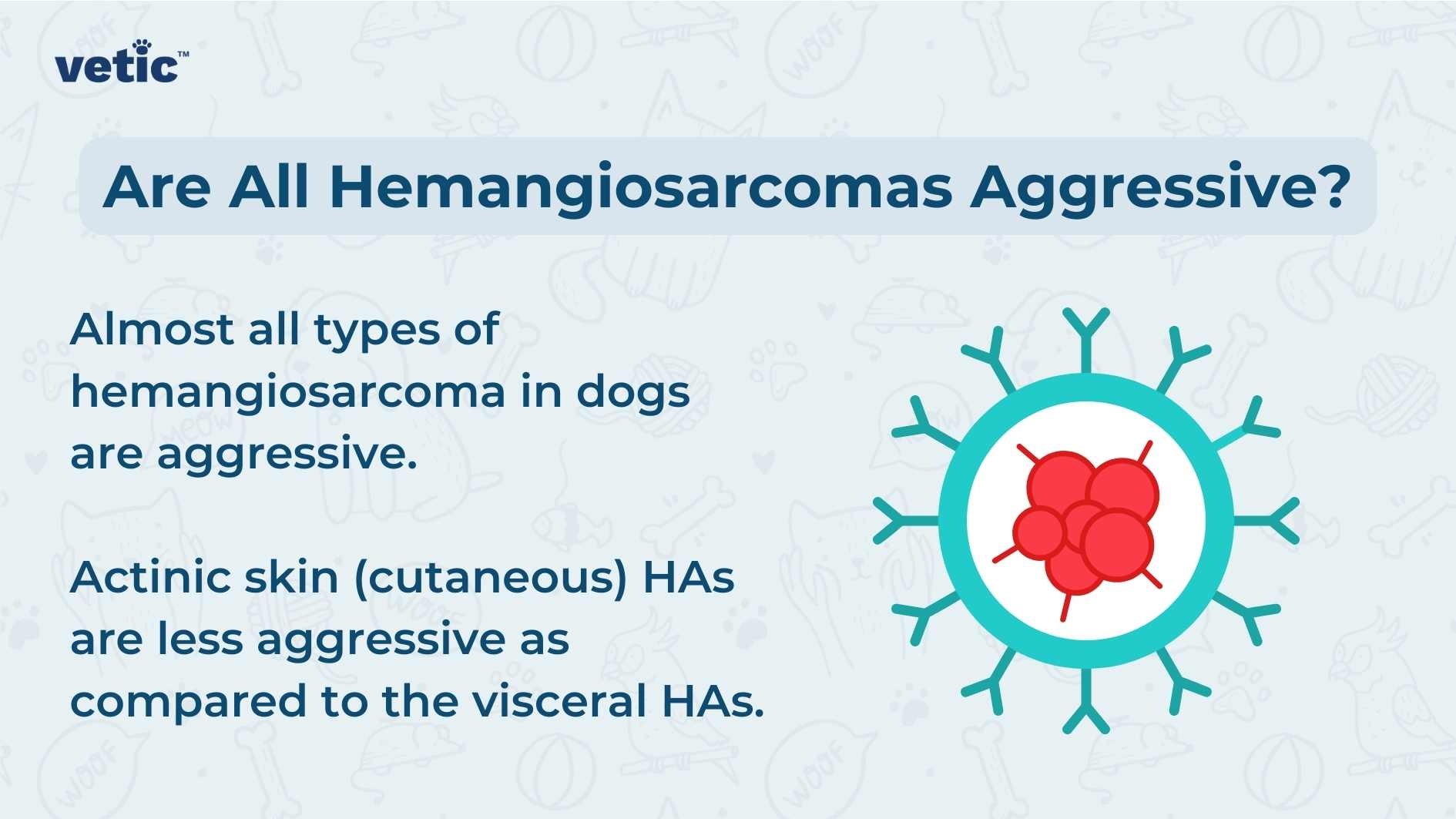
Almost all hemangiosarcoma in dogs are aggressive. Actinic skin (cutaneous) hemangiosarcoma are less aggressive as compared to the visceral forms of hemangiosarcoma and non-actinic hemangiosarcoma.
They are locally invasive or malignant tumours which can migrate to distant organs very fast. That is often the reason veterinarians insist on complete blood tests, multiple scans and USGs to check which organs have been affected before beginning the treatment.
What is the Prognosis of Hemangiosarcoma in Dogs: Recovery and Management
The outlook for dogs with hemangiosarcoma depends on several factors, including where the tumour is located, its size, and whether it has spread to other organs. Hemangiosarcoma is known for being very aggressive and quickly spreading (metastasis). While early detection and treatment can sometimes extend a dog’s life, the overall prognosis is often poor.
Splenic Hemangiosarcoma
- Without Surgery or Only Surgery: Dogs typically live between 2 weeks and 3 months after diagnosis if they don’t receive surgery or only have the spleen removed without chemotherapy.
- With Surgery and Chemotherapy: Survival time can increase to around 9 months, but less than 10% of dogs live beyond 1 year after diagnosis.
Cardiac Hemangiosarcoma
- General Prognosis: This type of hemangiosarcoma is incurable and comes with a very poor prognosis.
- Palliative Care: Focuses on comfort and quality of life.
- Survival Time: Some dogs may live up to 4 months with chemotherapy. Without treatment, survival may be only a few days to 2 weeks.
- High Risk: These dogs have a high risk of fatal heart arrhythmias.
Cutaneous/Subcutaneous Hemangiosarcoma
- Cutaneous (Skin) Hemangiosarcoma:
- Better Prognosis: Generally has a better outcome, especially if caused by UV exposure, as these tumours rarely spread to other organs.
- Post-Surgery Survival: Dogs may live for years after the tumour is removed.
- Monitoring: It’s important for pet parents to regularly check areas exposed to UV and remove any recurring tumours promptly.
- Subcutaneous (Under the Skin) Hemangiosarcoma:
- Worse Prognosis: This form has a more challenging outlook because the tumour spreads deeper into the skin and muscle layers.
- Survival Time: Often measured in months, even with treatment.
Follow-Up Care for Hemangiosarcoma in dogs
Dogs treated with surgery, chemotherapy, or radiation therapy require:
- Frequent Check-Ups: Regular visits to the vet.
- Bloodwork: To monitor health and catch any issues early.
- Diagnostic Imaging: To track the disease’s progress.
Can You Prevent Hemangiosarcoma?
Since we don’t know what causes hemangiosarcoma in some dogs of the highly predisposed breeds, there is no way to prevent it. If you have a white, short-haired dog of a predisposed breed, you can only ensure minimal UV exposure. Frequent veterinary examinations are essential for the early detection of this cancer which can contribute to a longer survival time.
Can You Understand If Your Dog Has Hemangiosarcoma in the Early Stages?
It is often impossible to detect visceral hemangiosarcoma in dogs in the early stages since they do not show any signs. The maximum signs they might show can include lethargy, some weight and appetite changes, coughing and gagging, which are easy to confuse with other conditions. Only complete diagnostics can reveal hemangiosarcoma in its early stages.
Is Hemangiosarcoma in Dogs Painful?
Depending on the location of the tumour and its nature, it can be painful for dogs. Skin hemangiosarcomas often begin as small growths resembling skin tags and they may not be as painful in their early stages.
Should You Try a Natural Remedy for Hemangiosarcoma?
Absolutely not! We know how your love for your dog can make you want to try popularised natural remedies. However, none of them have any evidence of working based on research. In reality, despite ongoing research, no natural herb or extract has shown to be effective in the treatment of hemangiosarcoma in dogs.
Your Doctor has Suggested ECT for Localised Cancer. Should You Go For It?
If your veterinarian has suggested ECT (electrochemotherapy) you should ask about the possible side effects, its effects on your dog’s quality of life and improvement possibilities. ECT is highly effective in treating localised cancer in dogs and humans. If your dog has no metastases and ECT has better outcome possibilities as compared to conventional chemotherapy and radiation therapy, you should definitely consider it!

